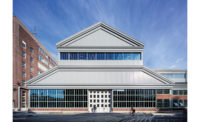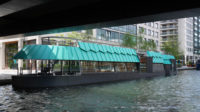If creativity and coolness are measured in bicycles per capita, then the Brooklyn Navy Yard is the coolest place on Earth. Take a tour and you will see prototypes of the docking stations for New York City’s recently-launched bike share program: it was tested out on the Navy Yard’s grounds. You’ll also see bike racks designed to look like ships made by Ferra Designs, a metalworking firm in the Navy Yard. Go into any office and there are retro fixed-gear bikes hanging on the walls, next to mod-ish vintage couches and coffee makers.
The Brooklyn Navy Yard once stood as a hulking emblem of American industrial might. Located in a semi-circular bend on the East River across from Manhattan’s Lower East Side, it is spread out over 300 acres and encompasses 40 buildings, three dry docks, and four active piers. In the early 20th century, it was where some of the nation’s most famed battleships—such as the USS Arizona, which was sunk at Pearl Harbor—were built. But it shrank after World War II, closed in 1966, and remained a symbol of urban decline and decay. The New York City government used it as an impound lot and stored Department of Justice files there. It had virtually no connection to the surrounding communities that suffered decades of abandonment, poverty, and high crime rates.
Now, much like the Fort Greene, Clinton Hill, Williamsburg, and DUMBO neighborhoods that surround it, the Navy Yard is on the upswing: a handful of high-end design and fabrication firms are showing the way to a revival of urban manufacturing. The Brooklyn Navy Yard Development Corporation (BNYDC) works to replace storage with active uses that will create more jobs.
Steiner Studios, where HBO’s “Girls” is filmed, was greeted with fanfare in 2004. But the growing trend at the Navy Yard is to lease space to design firms that can work with one another. Situ Studio is one example. Founded in 2005 by four architecture students from Cooper Union, Situ is a fabrication shop and a design firm. They have an office in DUMBO but they needed a larger fabrication space for their growing business. Their friends at Crye Associates, a firm founded by fellow Cooper Union alums who use emerging technology to design and prototype products such as body armor and helmets for the military, were already located in the Navy Yard. “We found the Navy Yard is an incredible incubator for progressive, technologically innovative manufacturing,” says Brad Samuels, a Situ partner. Also next door is Ferra, which does fine metal fabrication. “They have a water jet cutter,” explains Samuels. “So if we need parts cut out of metal, we would use them because we are limited in what we can do with metal.”
Situ’s Navy Yard space is in a 10,000-square-foot brick building that looks like a cross between a hangar and a barn and is only a 15 minute walk away from their DUMBO design office. “Part of the appeal of the Navy Yard is the historic buildings,” notes Andrew Kimball, president and CEO of BNYDC. “People want to be in buildings with character, and there is a shortage of them.
This is the model that the Navy Yard is trying to expand upon with New Lab. Projected to open 2015, it will be an incubator for small start-ups that can collaborate and share machines for 3D printing and metal laser sintering that would be prohibitively expensive for any of them to buy individually. A steel, U-shaped facility with 70-foot ceilings, which once housed three machine shops, will now be home to New Lab and Crye.
This kind of collaboration means that small design firms can now quickly produce their own prototypes in-house. That capability will be enormously helpful to planned tenants such as Within Labs, an engineering design, software, and consulting company based in London that wanted to open a New York office and uses the laser sintering machine to prototype products such as medical devices.
Unlike Within, most of the tenants will be small, Brooklyn-based operations. For example, Terreform ONE, a nonprofit design group and “ecological lab,” will be located there. Currently, they are housed in a temporary space next door. Terreform explores green design in cities, and recently studied how New York could produce its own food, water, and energy. One good example of what they envision can already be found in the Navy Yard: Brooklyn Grange, a 2.5-acre rooftop farm.
Meanwhile, the Navy Yard is trying to soften its edges to reconnect with the surrounding neighborhoods. In places it is still hidden behind a shabby metal fence and a sign reading “No Trespassing: Government Property.” But elsewhere it is opening outward. A wall at its southwestern edge that was constantly being defaced with graffiti was replaced with a mural depicting the Navy Yard’s history, painted by children from the public elementary school across the street.
The Navy Yard also shares its history in a free museum that features relics such as canons constructed on-site. The museum is located in a restored colonial brick building designed by Thomas Ustick Walter, who also did parts of the U.S. Capitol. A new addition was designed by Beyer Blinder Belle and built by Capsys Corp, a modular builder based in the Navy Yard.
The tenants view the area as a cross between an artist colony and Silicon Valley. Jordan Brandt, a self-described technology futurist who rents space in the Navy Yard characterizes it as “the nexus of entrepreneurship.” Down the hall, Ed Jacobs, who runs D.N.I., a design consulting company, calls it “an environment of ideas.” That it certainly is, but it all comes down to one very important idea: that things are still being made in Brooklyn.














Post a comment to this article
Report Abusive Comment